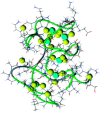Arsenic binding to proteins
- PMID: 23808632
- PMCID: PMC3797521
- DOI: 10.1021/cr300015c
Arsenic binding to proteins
Figures











Similar articles
-
Arsenic toxicology: five questions.Chem Res Toxicol. 2006 Jan;19(1):1-15. doi: 10.1021/tx050106d. Chem Res Toxicol. 2006. PMID: 16411650 Review. No abstract available.
-
Interactions of arsenic with human metallothionein-2.J Biochem. 2002 Aug;132(2):217-21. doi: 10.1093/oxfordjournals.jbchem.a003213. J Biochem. 2002. PMID: 12153718
-
An arsenic fluorescent compound as a novel probe to study arsenic-binding proteins.Protein J. 2012 Dec;31(8):656-66. doi: 10.1007/s10930-012-9441-6. Protein J. 2012. PMID: 22936492
-
Arsenic binding to human metallothionein.J Am Chem Soc. 2006 Sep 27;128(38):12473-83. doi: 10.1021/ja062914c. J Am Chem Soc. 2006. PMID: 16984198
-
Pyruvate dehydrogenase kinases (PDKs): an overview toward clinical applications.Biosci Rep. 2021 Apr 30;41(4):BSR20204402. doi: 10.1042/BSR20204402. Biosci Rep. 2021. PMID: 33739396 Free PMC article. Review.
Cited by
-
Arsenic trioxide and p97 inhibitor synergize against acute myeloid leukemia by targeting nascent polypeptides and activating the ZAKα-JNK pathway.Cancer Gene Ther. 2024 Oct;31(10):1486-1497. doi: 10.1038/s41417-024-00818-z. Epub 2024 Aug 9. Cancer Gene Ther. 2024. PMID: 39122830 Free PMC article.
-
Hazardous or Advantageous: Uncovering the Roles of Heavy Metals and Humic Substances in Shilajit (Phyto-mineral) with Emphasis on Heavy Metals Toxicity and Their Detoxification Mechanisms.Biol Trace Elem Res. 2024 Dec;202(12):5794-5814. doi: 10.1007/s12011-024-04109-4. Epub 2024 Feb 23. Biol Trace Elem Res. 2024. PMID: 38393486 Review.
-
Mass Spectrometry-Based Strategies for Assessing Human Exposure Using Hemoglobin Adductomics.Chem Res Toxicol. 2023 Dec 18;36(12):2019-2030. doi: 10.1021/acs.chemrestox.3c00294. Epub 2023 Nov 14. Chem Res Toxicol. 2023. PMID: 37963067 Free PMC article.
-
Toxic Mechanisms of Five Heavy Metals: Mercury, Lead, Chromium, Cadmium, and Arsenic.Front Pharmacol. 2021 Apr 13;12:643972. doi: 10.3389/fphar.2021.643972. eCollection 2021. Front Pharmacol. 2021. PMID: 33927623 Free PMC article. Review.
-
Arsenite-loaded nanoparticles inhibit PARP-1 to overcome multidrug resistance in hepatocellular carcinoma cells.Sci Rep. 2016 Aug 3;6:31009. doi: 10.1038/srep31009. Sci Rep. 2016. PMID: 27484730 Free PMC article.
References
-
- Cullen W. R.Is Arsenic an Aphrodisiac? The Sociochemistry of an Element; RSC Publishing: Cambridge, U.K., 2008; 412 pp.
-
- Oremland R. S.; Stolz J. F. Science 2003, 300, 939. - PubMed
-
- Nordstrom D. K. Science 2002, 296, 2143. - PubMed
-
- Jain C. K.; Ali I. Water Res. 2000, 34, 4304.
-
- Bhattacharya P.; Welch A. H.; Stollenwerk K. G.; McLaughlin M. J.; Bundschuh J.; Panaullah G. Sci. Total Environ. 2007, 379, 109. - PubMed
Publication types
MeSH terms
Substances
Grants and funding
LinkOut - more resources
Full Text Sources
Other Literature Sources
Medical

